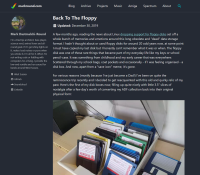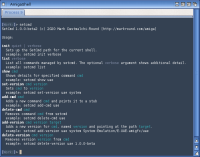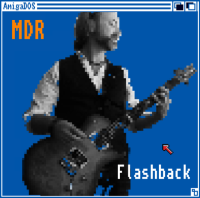The essential computing system for the discerning 90s teenage hacker. After getting started on a ZX Spectrum, the Amiga was my first “proper” computer system (thanks Mum, for that first A600!) which introduced me to shell scripting and systems programming, as well as providing an outlet for creative activities such as music production and creating pixel-art graphics. The Amiga led me to an awesome career and a lot of great times along the way. It’s still a lot of fun to develop for and muck about with in general, and it’s interesting to wonder what would the IT industry look like now if Commodore hadn’t collapsed.
Although there was just 3 years between the introduction of the Sinclar Spectrum and the Amiga 1000, seeing the Amiga for the first time was like a glimpse into the future. This page is my tribute to the computer that made the biggest impression on me, there’s a collection of my ‘miggy-related projects below and I always like to hear from old sceners so feel free to contact me if you remember the good old days!
Articles
 I’ve written a bunch of articles covering my experiences with both the “next-gen” PowerPC-based systems and my classic floppy-disk-equipped A1200. It’s all written with the perspective of an old Amigan becoming re-acquainted with the scene. I also covered my projects as I started developing for the Amiga again. I brushed off my rusty AmigaDOS and C skills, and got a modern cross-compiling setup which resulted in SetCmd.
I’ve written a bunch of articles covering my experiences with both the “next-gen” PowerPC-based systems and my classic floppy-disk-equipped A1200. It’s all written with the perspective of an old Amigan becoming re-acquainted with the scene. I also covered my projects as I started developing for the Amiga again. I brushed off my rusty AmigaDOS and C skills, and got a modern cross-compiling setup which resulted in SetCmd.
SetCmd
 SetCmd is a system utility written in C, originally for the modern PowerPC based AmigaOS 4.x. It lets you quickly and easily switch between different versions of installed software.
SetCmd is a system utility written in C, originally for the modern PowerPC based AmigaOS 4.x. It lets you quickly and easily switch between different versions of installed software.
I developed it both to solve a problem I had and to accompany a series of blog posts exploring the next-gen AmigaOS. I used it as an experiment to learn how to develop, package and distribute software for AmigaOS, as well as re-learning the C language along the way. I wanted to make the tool as Amiga-native as possible, so this meant things like:
- Providing an LISP-style Installer script to install the software
- Documentation in AmigaGuide format
- Using AmigaOS 4.x SDK functions and standards instead of “portable” C (options parsing via IDOS->ReadArgs instead of just pulling things out of argc, shell output through IDOS->Printf instead of printf in the C standard library, etc.)
I’ve since started porting it over to classic 16/32-bit 68k-based Amigas running OS 3.x, developing across Windows & Visual Studio as well as natively on my A1200 and X5000. I’ve learned so much about the inner workings of AmigaOS in this project, and have even deeper admiration for the sheer beauty of what the Amiga engineers managed to create back in the 1980s. Truly a machine ahead of its time and an absolute joy to develop for.
- Website: github.com/markround/setcmd
- Download from AmiNet: setcmd.lha
- Download from OS4Depot: setcmd.lha
- Articles: All Amiga blog posts and articles in the archives
AmigaGuide Reference Library
 I’ve started building a reference library of AmigaGuide documents that I frequently reference, and made them available through a web-browser using the AmigaGuideJS tool. Mostly for my own use, but I hope others find it useful - there’s some really great resources and information in them, and it’s convenient to be able to access them without access to an Amiga or installing a viewer tool.
I’ve started building a reference library of AmigaGuide documents that I frequently reference, and made them available through a web-browser using the AmigaGuideJS tool. Mostly for my own use, but I hope others find it useful - there’s some really great resources and information in them, and it’s convenient to be able to access them without access to an Amiga or installing a viewer tool.
Flashback
One of my early music projects and my tribute to the Amiga: A rock / metal cover of an old song from an amiga demo! I also made a proper music video for this. The original was called “Jobba” and was written by Pex “Mahoney” Tufvesson. He is a legend in the Amiga & Commodore-64 scenes, and his Noisetracker program kick-started my interest in computer-based music. I used to love this track and even made a mixtape back in the day with this on it, so it seemed only fitting to give it the MDR treatment!
I also wrote to Pex letting him know I’d made a tribute to one of his old tracks and we exchanged a few really nice emails. He was also kind enough to include my video and my letter to him in an fascinating talk he gave at a scene conference.
